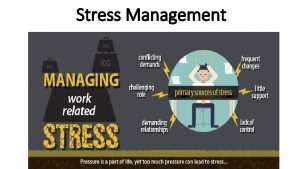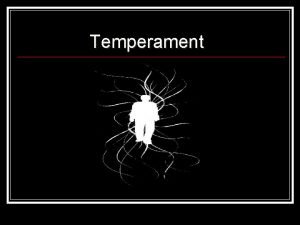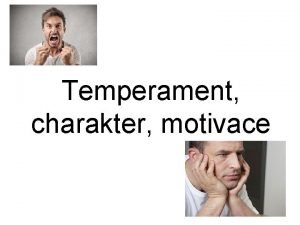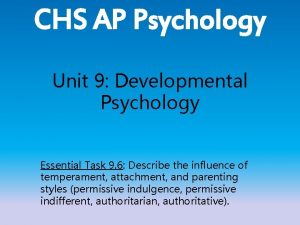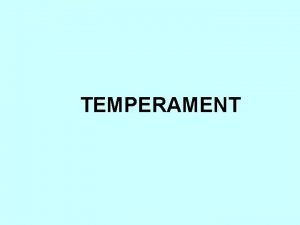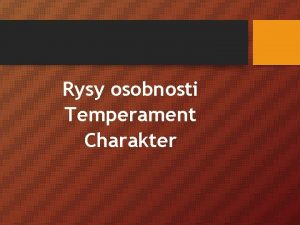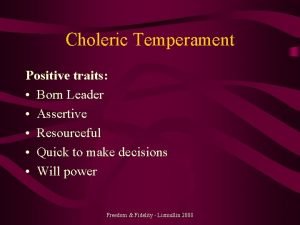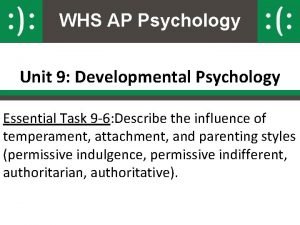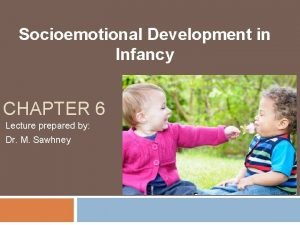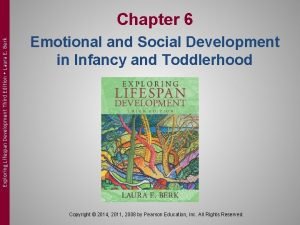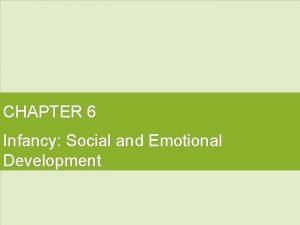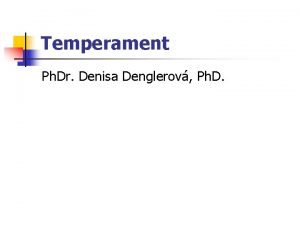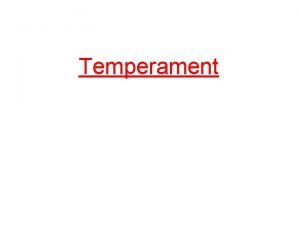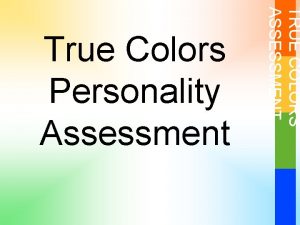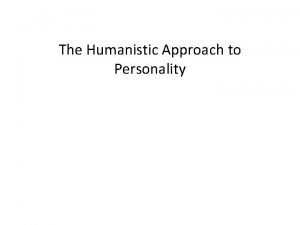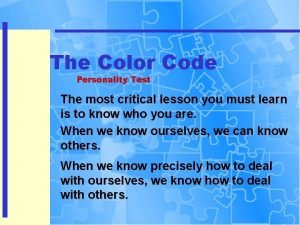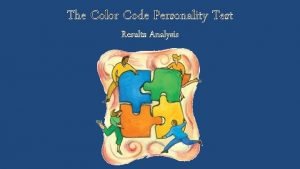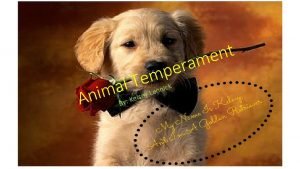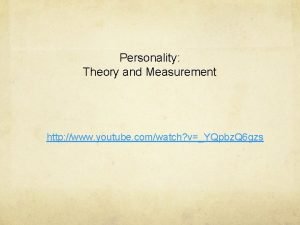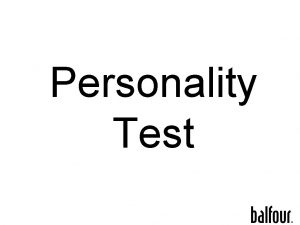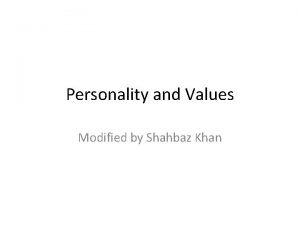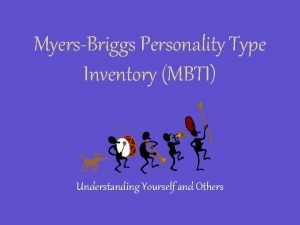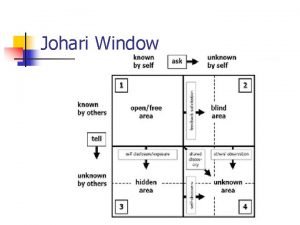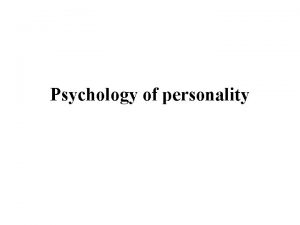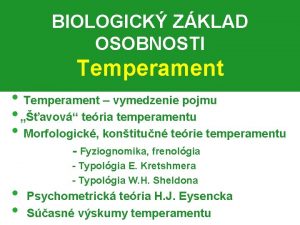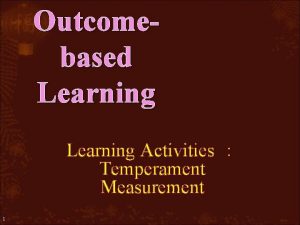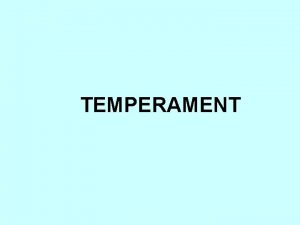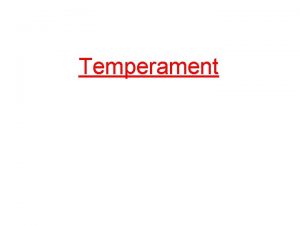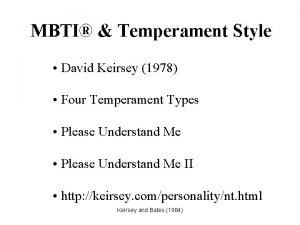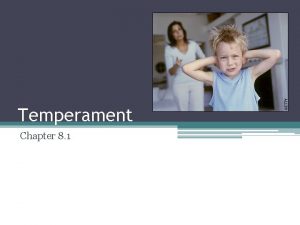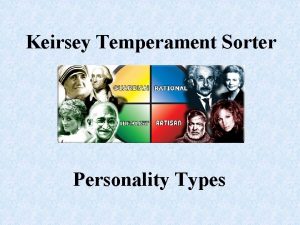Temperament Personality Test Outline What 3 is temperament




















































- Slides: 52

Temperament

Personality Test!

Outline �What � 3 is temperament? Approaches �Stability of Temperament �Causes and Outcomes of Temperament

Defining Temperament �Early emerging individual differences in characteristic patterns of emotional, behavioral, and motor responding (Rothbart & Bates 2006; Goldsmith, 1987; Calkins & Degnan, 2006) �Generally considered to have a biological or genetic basis �Generally time stable across contexts and over �Foundation for later personality

Temperamental Characteristics �Negative emotionality �Positive emotionality �Behavioral inhibition �Activity level �Approach behavior �Persistence �Fearfulness

Temperament & Personality �Temperamental characteristics provide the early building blocks for personality �Dimensions are correlated with Big Five personality characteristics �Personality broader ◦ Beliefs, motivation, values

3 Approaches to Temperament �Multiple theoretical approaches to temperament �These approaches vary: ◦ In number of temperament dimensions proposed ◦ Emphasis on emotion vs. behavior

Approach #1: Rothbart and Bates Approach �Two broad dimensions: Reactivity and Regulation (Rothbart, 2007; Rothbart & Bates, 2006) �Measured along multiple dimensions that place emphasis on basic emotion, attention, and motor behaviors ◦ Create broad dimensions based on these basic components of temperament

Rothbart and Bates’ Dimensions Temperament Dimensions Negative Emotionality Surgency Rothbart’s Dimensions Effortful Control

Negative Emotionality Fear Anger Frustration Sadness

Negative Affectivity (Reactivity) Dimension Definition Frustration Amount of negative affect related to interruption of ongoing tasks or goal blocking. Fear Amount of negative affect, including unease, worry or nervousness related to anticipated pain or distress and/or potentially threatening situations. Sadness Amount of negative affect and lowered mood and energy related to exposure to suffering, disappointment and object loss. Discomfort Amount of negative affect related to sensory qualities of stimulation, including intensity, rate or complexity of light, movement, sound, texture. Soothability Rate of recovery from peak distress, excitement, or general arousal. Putnam & Rothbart, 2006

Surgency Activity Level Approach High Intensity Pleasure Impulsivity

Exuberance/Surgency (Reactivity) Dimension Definition Activity Level of gross motor activity including rate and extent of locomotion. Approach Amount of excitement and positive anticipation for expected pleasurable activities. Smiling and Amount of positive affect in response to changes in Laughter stimulus intensity, rate, complexity, and incongruity. Shyness (low) Slow or inhibited approach in situations involving novelty or uncertainty. High Intensity Amount of pleasure or enjoyment related to situations Pleasure involving high stimulus intensity, rate, complexity, novelty and incongruity. Impulsivity Speed of response initiation. Putnam & Rothbart, 2006

Effortful Control Low Intensity Pleasure Attentional Control Perceptual Sensitivity Inhibitory Control

Effortful Control (Regulation) Dimension Definition Attentional Focusing Tendency to maintain attentional focus upon task-related channels. Inhibitory Control The capacity to plan and to suppress inappropriate approach responses under instructions or in novel or uncertain situations. Low Intensity Pleasure Amount of pleasure or enjoyment related to situations involving low stimulus intensity, rate, complexity, novelty and incongruity. Perceptual Sensitivity Detection of slight, low-intensity stimuli from the external environment. Putnam & Rothbart, 2006

Individual Differences in Regulation �Children’s �Two ability to mask disappointment things to keep in mind: ◦ There are no methodological controls ◦ This is not a good parenting strategy �Jimmy Kimmel You. Tube Challenge ◦ (WARNING: Some inappropriate language)

During everyday activities, how often did your child… Pay attention to you right away when you called to him/her? B. Seem to be irritated by tags in his/her clothes? C. Become bothered by sounds while in noisy environments? D. Seem full of energy, even in the evening? A. ECBQ; Rothbart & colleagues

Let’s evaluate the children’s temperament. �Matthew �Exasperating! �Kai �Apparently 18 © 2015 M. Guthrie Yarwood

Match Temperament Factors to Big Five! 19 Factors Big Five � Negative � Openness Affectivity � Surgency � Effortful Control to Experience � Conscientiousness � Extraversion � Agreeableness � Neuroticism © 2013 The Mc. Graw-Hill Companies, Inc. All rights reserved.

Gender Differences? Exuberant – Surgency (Extraversion) Negative Affectivity Effortful Control (Neurotiscism) (Conscientousness)

Approach #2: Thomas & Chess Temperament Activity Description Is the child always moving and doing something OR does he or she have a more relaxed style? Rhythmicity Is the child regular in his or her eating and sleeping habits OR somewhat haphazard? Approach / withdrawal Does he or she "never meet a stranger" OR tend to shy away from new people or things? Adaptability Can the child adjust to changes in routines or plans easily or does he or she resist transitions? Intensity Does he or she react strongly to situations, either positive or negative, OR does he or she react calmly and quietly? 21 © 2015 M. Guthrie Yarwood

Approach #2: Thomas & Chess Temperament Description Mood Does the child often express a negative outlook OR is he or she generally a positive person? Does his or her mood shift frequently OR is he or she usually even-tempered? Persistence and Attention Span Does the child give up as soon as a problem arises with a task OR does he or she keep on trying? Can he or she stick with an activity a long time OR does his or her mind tend to wander? Distractibility Is the child easily distracted from what he or she is doing OR can he or she shut out external distractions and stay with the current activity? Sensory Threshold Is he or she bothered by external stimuli such as loud noises, bright lights, or food textures OR does he or she tend to ignore them? 22 © 2015 M. Guthrie Yarwood

Easy (40%) Difficult (10%) Slow to warmup (15 %) • Positive mood, high regularity, low intensity, adaptability, approach (not withdrawal) • Negative mood, irregularity, extreme intensity, slow to adapt, withdrawal, loud crying/laughter • Low activity, withdrawal, slower to adapt, somewhat negative mood, low intensity Video 23 © 2015 M. Guthrie Yarwood

What about the other 35% �The other children in Thomas and Chess’s (1977) study could not be classified: ◦ Displayed characteristics in a different configuration ◦ Were not consistent in the types of behaviors they displayed across different situations or over time

Approach #3: Behavioral Inhibition (Kagan) �Perspective focuses on two types of temperament: Inhibited and uninhibited �Thought to represent distinct approach vs. withdrawal tendencies to new situations and people

Behavioral Inhibition �Inhibited ◦ The tendency to withdraw from unfamiliar people and situations. Shy can also be fearful. �Uninhibited ◦ Do not withdraw in unfamiliar situations and with unfamiliar people ◦ (Exuberant – approach oriented)

Behavioral Inhibition: Stability �Infant Temperament �Distressed babies are more likely to be______ �Calm babies are more likely to be______ 27

Is temperament stable? �Rank-Order Stability �Mean-Level Change �Personality Coherence 28 © 2015 M. Guthrie Yarwood

Rank-Order Stability: Surgency, NA, and EC �ICBQ (1981; 3 -12 months) ◦ 3 -month stability; increases with time �ECBQ (2006; 1. 5 – 3 years) ◦ r =. 45 to. 80 �CBQ (2006; 3 to 8 years) ◦ r =. 63 to. 73 29 © 2015 M. Guthrie Yarwood

3 60 -7 9 -5 50 9 -4 40 9 -3 30 9 -2 22 9 -2 1. 9 18 7. 12 -1 . 9 6 - 11 9 5. 3 - 2. 9 Big Five Over Lifespan 0 - Rank-Order Consistency 1 0. 9 0. 8 0. 7 0. 6 0. 5 0. 4 0. 3 0. 2 0. 1 0 Age Periods (Roberts and Del. Vecchio, 2000). 30 Note. Big Five © 2015 M. Guthrie Yarwood

Is personality stable? �Rank-Order Stability �Mean-Level Change �Personality Coherence 31 © 2015 M. Guthrie Yarwood

Extraversion 2 3 6 Age Conscientiousness 8 15 2 3 6 Age 8 Openness to Experience 15 2 3 6 Age 8 Emotional Stability Agreeableness 2 3 15 2 3 6 Age 8 (Lamb et al. , 2002) 32 © 2015 M. Guthrie Yarwood 15 15

1. 2 Mean Level Change 1 Agreeableness 0. 8 Conscientiousness 0. 6 Emotional Stability 0. 4 Openness to Experience 0. 2 Extraversion: Assertiveness 0 15 -0. 2 30 50 65 Extraversion: Sociable, Lively Age (Roberts, Walton, & Viechtbauer, 2006) © 2015 M. Guthrie Yarwood 33

Big Five – Mean Level Change �ES and C ◦ Increase with age, then declines in old age �Agreeableness ◦ Increases or remains stable with age �Extraversion ◦ Social vitality/liveliness decreases with age ◦ Social dominance increases with age �Openness to Experience ◦ Curvilinear 34 © 2015 M. Guthrie Yarwood

Is personality stable? �Rank-Order Stability �Mean-Level Change �Personality Coherence 35 © 2015 M. Guthrie Yarwood

Personality Coherence �Traits are stable over time. �But, how people express the trait can change over time. �Example: Mischel’s Marshmallow Study ◦ Trait = Delay of gratification 36 © 2015 M. Guthrie Yarwood

Personality Coherence: Delay of Gratification ◦ TED � 4 - and 5 -year old children � 15 minutes: total time �≈ 9 minutes: Avg time before ate marshmallow � 11 -year follow-up at ages 15/16 37 © 2015 M. Guthrie Yarwood

Personality Coherence: Delay of Gratification 11 -years later (ages 15/16) 36 years later (40 s) � Higher SAT scores & GPA � Better � Lower BMIs � Less drug use � Higher � Better self-esteem regulation of stress � Greater self-control performance on self-control task � Brain Patterns ◦ Low-delayers: ventral striatum ◦ High-delayers: prefrontal cortex But, depends on predictability of environment! 38 © 2015 M. Guthrie Yarwood

Childhood Measure Adulthood Outcomes ↑ Extraversion • Positive Relationships (Peer, Romantic) • Aggression, Well-being ↑ Neuroticism • Social Difficulties • Lower occupational attainment in adulthood ↑ Conscientiousness ↑ Agreeableness ↑ Openness to Experience • Academic Achievement in childhood and adulthood • Career success (income / occupational status), job satisfaction • Positive Relationships • Positive Peer Relationships • Greater academic achievement and work competence • Reduced delinquency • Academic achievement and IQ, Creativity 39 © 2015 M. Guthrie Yarwood

Temperament Moderately Stable �Correlations over time range between. 35 to. 70 �More variability in infancy and greater stability after 2 years of age �Temperamental traits in infancy similar to traits when children were 7 years of age �High approach tendencies at 3 -years-old people rated themselves as more impulsive, spontaneous, and careless when they were 18 years of age

Causes and Outcomes of Temperament �Genetics �Biological Factors �Internalizing/Externalizing Problems �Socioemotional Outcomes �Peer Relationships �Goodness-of-Fit

Big Five: Genetics or Environment? r. MZ r. DZ h 2 c 2 e 2 Self-report . 54 . 27 . 54 0 . 46 Observerreport . 45 . 20 . 50 -. 05 . 55 Average of Self and Observer Reports . 65 42 © 2015 Borkenau M. Guthrie Yarwood (GOSAT; et al. , 2001)

Typical correlations of personality trait levels between relatives of various kinds Type of relative Identical twins raised together Identical twins raised apart Fraternal twins raised together Correlation. 45. 20 Nontwin biological siblings raised together Parent and biological child (together) Parent and biological child (apart) Adoptive siblings Adoptive parent and child . 20 Note. Averages across different traits and different samples of persons. . 10 -. 15. 00 -. 05 43 Yarwood M. Guthrie Table© 2015 adapted from Ashton (2013)

Biological Factors �Dopamine ◦ Extraversion, Openness �Serotonin ◦ Conscientiousness, Agreeableness ◦ Neuroticism (Low Serotonin) �Norepinephrine – Neuroticism �Testosterone ◦ Extraversion ◦ Agreeableness (Low T) �Oxytocin - Agreeableness

Internalizing and Externalizing Problems � Children who are more irritable, difficult, impulsive, and emotional experience a higher rate of problems in later life � Fearful, shy children → Internalizing problems ◦ Childhood behavior problem in which the behavior is directed at the self rather than others, including fear, anxiety, depression, loneliness, and withdrawal � Poor effortful control → Externalizing problems ◦ childhood behavior problem in which the behavior is directed at others, including hitting, stealing, vandalizing, and lying What might contribute to these associations?

Socioemotional Outcomes �High Surgency/High Effortful control ◦ Children more likely to explore environment �High Surgency / Low Effortful Control ◦ More likely to exhibit high levels of externalizing behavior problems �High Negative Emotionality / Low EC ◦ Linked to externalizing and internalizing behavior problems & lower social competence

Peer Relationships �In general, temperament has been found to influence peer relationships �Inhibition �Lower predicts withdrawal from peers peer acceptance ◦ Higher negative emotionality ◦ High activity ◦ Low persistence

Goodness-of-Fit �Child’s Adjustment = Child’s temperament PLUS match b/w temperament and environment. �Development is optimized when parents’ child-rearing practices are sensitive to the child’s temperamental characteristics

Goodness-of-Fit Situational Characteristics Parenting Characteristics Child Temperament 49

Goodness-of-Fit �Children high on negative affectivity who have parents who are sensitive more likely to have better adaptation. �Toddlers high on behavioral inhibition are less likely to exhibit later shyness if their parents are not overprotective or insensitive �BBC Video (1: 35)

Summary �Children exhibit a narrower range of emotions and temperaments �As children age, they experience more emotions and express broader personality traits �Temperament is caused by genetics, nonshared environ, and biology

Have a good day!
 Test de temperament pentru elevi
Test de temperament pentru elevi Test keirsey
Test keirsey Www.123 test.com/disc-personality-test/
Www.123 test.com/disc-personality-test/ Www.123 test.com/disc-personality-test/
Www.123 test.com/disc-personality-test/ Flavorful sentence
Flavorful sentence Temperament osobnosti
Temperament osobnosti Temperament jak z bajki
Temperament jak z bajki Temperament vs charakter
Temperament vs charakter übez
übez Interakcyjna teoria temperamentu
Interakcyjna teoria temperamentu Premorbid temperament
Premorbid temperament Choleric strengths and weaknesses
Choleric strengths and weaknesses Temperament ap psychology
Temperament ap psychology Pyknik astenik atletik
Pyknik astenik atletik Melancholik
Melancholik Test hipokratesa galena
Test hipokratesa galena Temperament wladik
Temperament wladik Dział mechaniki klasycznej
Dział mechaniki klasycznej Choleric personality traits
Choleric personality traits Secure vs insecure attachment ap psychology
Secure vs insecure attachment ap psychology Involves individual differences in behavioral styles
Involves individual differences in behavioral styles Thomas and chess temperament
Thomas and chess temperament Platypus temperament
Platypus temperament Thomas and chess temperament
Thomas and chess temperament Three types of temperament
Three types of temperament Temperament psychology
Temperament psychology History of pet therapy
History of pet therapy Temperament
Temperament Resilient temperament definition
Resilient temperament definition Hippokrates temperament
Hippokrates temperament Cholerik význam
Cholerik význam Relatia dintre temperament si aptitudini
Relatia dintre temperament si aptitudini Kretschmerova typologie osobnosti
Kretschmerova typologie osobnosti Color wheel personality test
Color wheel personality test True colors learning styles
True colors learning styles Blue true color personality
Blue true color personality Color personality test gold green blue orange
Color personality test gold green blue orange Dalai lama personality test
Dalai lama personality test Tibetan personality test
Tibetan personality test Hartman personality profile
Hartman personality profile Maslow humanistic theory of personality
Maslow humanistic theory of personality Color code
Color code What personality is blue
What personality is blue Otter personality test
Otter personality test Gary smalley animal personality test
Gary smalley animal personality test Www.16 personalities.com/free-personality-test
Www.16 personalities.com/free-personality-test 16 personalities.com/free-personality-test
16 personalities.com/free-personality-test Objective personality
Objective personality Personality test greek
Personality test greek Personality test pig drawing
Personality test pig drawing Genghis khan mbti type
Genghis khan mbti type Make me bark mbti
Make me bark mbti Window to window mbti
Window to window mbti


